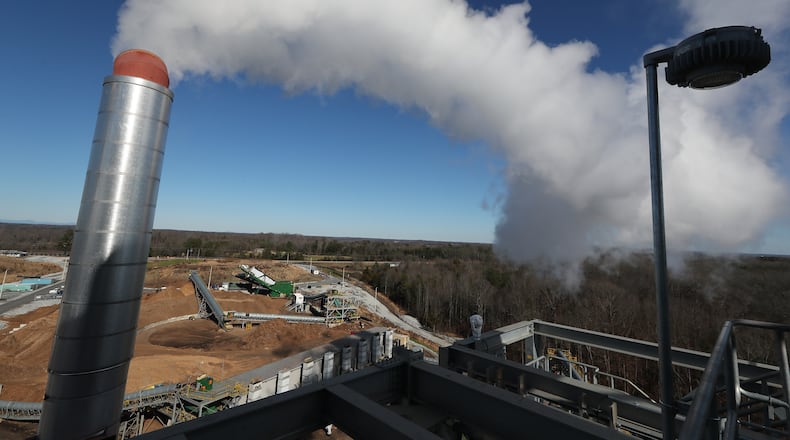Early one morning in mid-December, Cheryl Adams got out of bed and peered outside. The fog that obstructed her view of the industrial plant in Colbert less than a mile from her front door was now moving in a different direction. She could see the smokestacks again and she realized it wasn’t fog, it was coming from the plant.
“There was so much smog you couldn’t hardly see in front of your face,” she said. She worried every time the biomass plant started up, emitting exhaust she said left her feeling as if her breakfast was burning its way down her throat and into her stomach.
Credit: Curtis Compton / Curtis.Compton@
Credit: Curtis Compton / Curtis.Compton@
For more than a year, Adams and other residents in northeastern Georgia have shared their communities with twin biomass plants in Colbert and Carnesville that began operating in summer 2019.
Biomass — burning organic material such as wood or animal waste to generate energy — accounted for only 1% of electricity generation in 2019, according to the U.S. Energy Information Administration; it’s a small amount when compared to natural gas (38%) and coal (23%). In Georgia, almost half of the 9% of energy that comes from renewable resources (solar, hydroelectric power, etc.) is biomass.
The battle over biomass in Georgia and across the Southeast region marks another environmental clash between residents in rural areas who say their quality of life is at stake and an industry that says it’s boosting the local economy and supporting one of the biggest industries in the state.
“We are very excited because everything we do helps the environment,” said Steve Dailey, president of Georgia Renewable Power, which supplies energy to Georgia Power. “We burn mostly waste wood or residue from operations ... We are cleaning up limbs and debris that would be left in the forest.”
Georgia has 15 energy product mills, according to the Georgia Forestry Commission, nine of which are pellet mills that manufacture pellets from wood residue. The pellets are exported primarily to European markets where they are burned for energy generation.
The state’s abundant timberlands provide fuel — tree stumps, treetops, trimmed branches — for biomass energy, but wood sources have also included discarded construction materials such as pallets and wood planks and rail ties treated with creosote, a wood preservative made from a mixture of chemicals that gives off toxic fumes when burned, according to the federal Environmental Protection Agency.
Credit: Curtis Compton / Curtis.Compton@
Credit: Curtis Compton / Curtis.Compton@
State legislation aimed at the two plants to prevent the burning of rail ties solely for energy generation cleared both chambers and was signed into law in August, largely due to the efforts of residents who are now focused on addressing concerns about noise pollution caused by plant operations — the constant loud whoosh of the wood dryers, the slap of the bulldozers moving wood products as early as 6 a.m. and as late as midnight, and the occasional high-pitched whistle of a emergency steam release.
With a 30-year contract to provide energy to Georgia Power and having secured a $500 million green loan — an investment class that requires certain renewable energy practices to be upheld — Georgia Renewable Power will be around for many years to come, Dailey said, and more biomass plants are on the horizon in the Southeast.
Enviva, the largest producer of wood pellets in the world, recently purchased an existing biomass plant in Waycross in southeast Georgia. Industry insiders say plans for at least three more biomass facilities in Georgia are in the works, but residents say they find out about the facilities only when permits are issued by state regulators.
“If you didn’t know anything about it, you had to have not been paying attention to any news source,” said state Sen. Frank Ginn, R-Danielsville, referring to the construction of the Georgia Renewable Power facilities. “I can’t force you to look at what is going on in your community, but if you cared to look, we are fully open in everything that we do.”
Ginn, who served as Franklin County manager until his election to the Senate, said the plants seemed like a good opportunity for both the county where he once served as manager and the one he now represents in the Senate.
Credit: Curtis Compton / Curtis.Compton@
Credit: Curtis Compton / Curtis.Compton@
“It is jobs and investment and everything you want to happen in your county. They were going to burn treetops and construction waste as their fuel source,” he said. They were also going to be among the top taxpayers, paying over $2 million in each county annually, he said, quoting figures that were confirmed by Dailey.
But when the plant in Madison County fired up a few days after the 4th of July in 2019, job creation and tax revenue were the last things on residents’ minds. “The noise was horrific,” said Gina Ward, a mother of three, who lives in the area and had purchased property in 2007 seeking a refuge from the crowded environs of Gwinnett County.
With 25 acres in the middle of the woods, she and her husband built a path lined with handmade signs and wind chimes that led to a sitting area and fire pit just beside the creek that runs through the property. But whenever the plant started up, it felt as if they were sitting in the middle of Hartsfield-Jackson International Airport.
Ward began attending county commission meetings, and a few months later, she invited 10 strangers to her home. They decided to work together to educate residents on what biomass is and what it could mean for the community. They specifically wanted to stop the plants from burning rail ties even though federal regulations allow the creosote-treated ties to be burned at biomass facilities if certain conditions are met.
“It is a toxic soup of air pollution that is emitted from a biomass burning facility,” said Paul Billings, senior vice president of advocacy for the American Lung Association. “There is a fairy tale about a woodsman with his ax chopping down oak trees, cutting them with a crosscut saw and feeding them into a wood-burning device. The reality is, this is an industrial-sized activity and it is not just hardwoods or even trees. It is construction and demolition materials and other waste products that are being burned.”
Credit: Curtis Compton / Curtis.Compton@
Credit: Curtis Compton / Curtis.Compton@
Nitrogen oxides create ozone and smog that contains particles which can lead to coughing and wheezing in healthy adults and exacerbation of problems in individuals with asthma, COPD or other conditions, Billings said.
Just over a year ago, some area residents took their complaints directly to Rep. Alan Powell, R-Hartwell.
“They were telling me the ash from the plant was settling on their cars, gardens and plants,” Powell said. And they told him there were truckloads of railroad ties on the property that the plants were using as source material.
By February, Powell had drafted legislation that would prevent companies from burning railroad ties for energy generation. In August, Powell’s bill became law, but residents said they are still battling the nuisances the plant has brought to their lives and homes.
“I am by no means making light of the fact that the people there feel like we are intruders, but we are working towards trying to go above and beyond,” said Dailey. “We are well within our compliance with the state of Georgia. The EPD (Environmental Protection Division) doesn’t allow you to step out of bounds.”
A spokesperson for EPD confirmed both of the facilities are currently in compliance with agency regulations.
Dailey said he met with Gov. Brian Kemp and agreed not to challenge the legislation on rail ties in order to make amends with the community. But as a result of the new legislation, the company has lost 20% of its fuel source, he said. They now burn mostly wood waste and construction and demolition materials that would otherwise end up in the landfill, he said.
Credit: Curtis Compton / Curtis.Compton@
Credit: Curtis Compton / Curtis.Compton@
The plants generate enough clean energy to power about 464,000 homes each year assuming normal consumption, according to representatives of Georgia Renewable Power. But there is an ongoing debate about whether biomass should be considered renewable energy.
The trees from which Georgia’s biomass energy is generated can be replanted to offset the carbon produced from burning, thereby making biomass “carbon neutral.” But burning wood emits large amounts of carbon into the air that can’t immediately be offset.
As the cost of natural gas and renewable energy sources such as solar and wind power has decreased, the economics of biomass have also come under scrutiny.
In the 2019 resource plan, Public Service Commissioner Jason Shaw put forth a motion that required Georgia Power, the largest utility in the state, to add a biomass facility with the capacity to power 44,000 homes each year.
The project, currently out for bid, does not have to compete against less expensive forms of renewable energy. “We are trying to do a little biomass because of the other economic benefits to the rural communities that are struggling ... 50 megawatts isn’t a lot but it certainly keeps things moving in the direction if we do more with biomass,” Shaw said in an interview with the AJC.
But some residents said the economic benefits are not worth the headache of having a biomass plant in the backyard. “Getting rid of rail ties was low-hanging fruit for us,” said Ward. “I want to empower people to know they have the right to speak up.”
Ward and other residents are now awaiting results of a noise study, a joint partnership between Madison County and Georgia Renewable Power, while also working with other organizations to help prevent additional biomass plants from opening without considerable input from the communities that may be impacted.
And on those nights when the wind blows toward her bedroom window, Adams said she prays for it to change direction, then feels guilty that it could be heading to one of her neighbors.
BY THE NUMBERS
The biomass and wood pellet industries have been on the rise for more than a decade in the South, where abundant timberland acreage offers plenty of source material. Georgia leads the nation in biomass fuel manufacturing capacity and serves as a leading exporter of wood pellets, according to federal data.
10.6% share of U.S. utility-scale biomass net electricity generation produced in Georgia
2nd in the nation after California in the amount of electricity generation from all sources of biomass
15 energy product facilities in the state that burn wood or wood waste, nine of which are pellet mills
24.5 million acres of forestland in Georgia, almost all of which (22.2 million acres) is privately owned
Sources: U.S. Energy Information Administration, Georgia State Energy Profile (Nov. 2020) and Georgia Forestry Commission
WHAT IS BIOMASS ENERGY?
Biomass energy is energy produced from plant or animal materials. In Georgia, where two-thirds of the state is forested and forest growth exceeds removals by 48%, wood and wood waste is abundant source material for biomass. Though trees are renewable, there is ongoing debate about whether biomass is carbon neutral, and with more affordable options for renewable energy such as gas and solar, there is also concern about costs tied to biomass generation for in-state use.
About the Author
Keep Reading
The Latest
Featured








